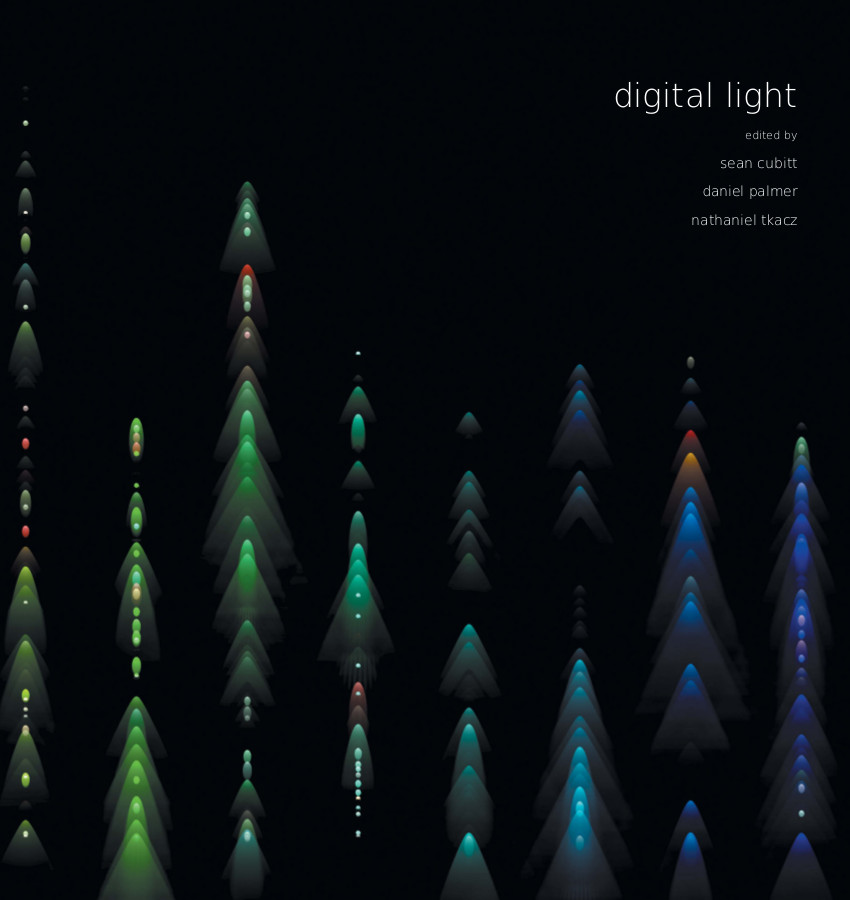Sean Cubitt, Daniel Palmer, Nathaniel Tkacz (eds.): Digital Light (2015)
Filed under book | Tags: · aesthetics, art, cinema, digital, film, image, light, optics, photography, screen, technology, vision

“Light symbolises the highest good, it enables all visual art, and today it lies at the heart of billion-dollar industries. The control of light forms the foundation of contemporary vision. Digital Light brings together artists, curators, technologists and media archaeologists to study the historical evolution of digital light-based technologies. Digital Light provides a critical account of the capacities and limitations of contemporary digital light-based technologies and techniques by tracing their genealogies and comparing them with their predecessor media. As digital light remediates multiple historical forms (photography, print, film, video, projection, paint), the collection draws from all of these histories, connecting them to the digital present and placing them in dialogue with one another.
Light is at once universal and deeply historical. The invention of mechanical media (including photography and cinematography) allied with changing print technologies (half-tone, lithography) helped structure the emerging electronic media of television and video, which in turn shaped the bitmap processing and raster display of digital visual media. Digital light is, as Stephen Jones points out in his contribution, an oxymoron: light is photons, particulate and discrete, and therefore always digital. But photons are also waveforms, subject to manipulation in myriad ways. From Fourier transforms to chip design, colour management to the translation of vector graphics into arithmetic displays, light is constantly disciplined to human purposes. In the form of fibre optics, light is now the infrastructure of all our media; in urban plazas and handheld devices, screens have become ubiquitous, and also standardised. This collection addresses how this occurred, what it means, and how artists, curators and engineers confront and challenge the constraints of increasingly normalised digital visual media.
While various art pieces and other content are considered throughout the collection, the focus is specifically on what such pieces suggest about the intersection of technique and technology. Including accounts by prominent artists and professionals, the collection emphasises the centrality of use and experimentation in the shaping of technological platforms. Indeed, a recurring theme is how techniques of previous media become technologies, inscribed in both digital software and hardware. Contributions include considerations of image-oriented software and file formats; screen technologies; projection and urban screen surfaces; histories of computer graphics, 2D and 3D image editing software, photography and cinematic art; and transformations of light-based art resulting from the distributed architectures of the internet and the logic of the database.”
Publisher Open Humanities Press, London, 2015
Fibreculture Books series
Creative Commons BY-SA 4.0 License
ISBN 1785420089, 9781785420085
224 pages
Review: Mathias Denecke (Culture Machine, 2016).
PDF, PDF, PDF (4 MB, updated on 2016-7-19)
Comment (0)Stamatia Portanova: Moving without a Body: Digital Philosophy and Choreographic Thoughts (2013)
Filed under book | Tags: · abstraction, aesthetics, affect, algorithm, body, choreography, code, composition, computation, computing, dance, digital, geometry, image, infinity, mathematics, mind, movement, number, object, philosophy, sensation, virtual

“Digital technologies offer the possibility of capturing, storing, and manipulating movement, abstracting it from the body and transforming it into numerical information. In Moving without a Body, Stamatia Portanova considers what really happens when the physicality of movement is translated into a numerical code by a technological system. Drawing on the radical empiricism of Gilles Deleuze and Alfred North Whitehead, she argues that this does not amount to a technical assessment of software’s capacity to record motion but requires a philosophical rethinking of what movement itself is, or can become.
Discussing the development of different audiovisual tools and the shift from analog to digital, she focuses on some choreographic realizations of this evolution, including works by Loie Fuller and Merce Cunningham. Throughout, Portanova considers these technologies and dances as ways to think—rather than just perform or perceive—movement. She distinguishes the choreographic thought from the performance: a body performs a movement, and a mind thinks or choreographs a dance. Similarly, she sees the move from analog to digital as a shift in conception rather than simply in technical realization. Analyzing choreographic technologies for their capacity to redesign the way movement is thought, Moving without a Body offers an ambitiously conceived reflection on the ontological implications of the encounter between movement and technological systems.”
Publisher MIT Press, 2013
Technologies of Lived Abstraction series
ISBN 0262018926, 9780262018920
200 pages
Reviews: Donnarumma (Mute, 2014), Murphy (Afterimage, 2014), Thain (Digicult).
PDF (11 MB)
Comment (0)
